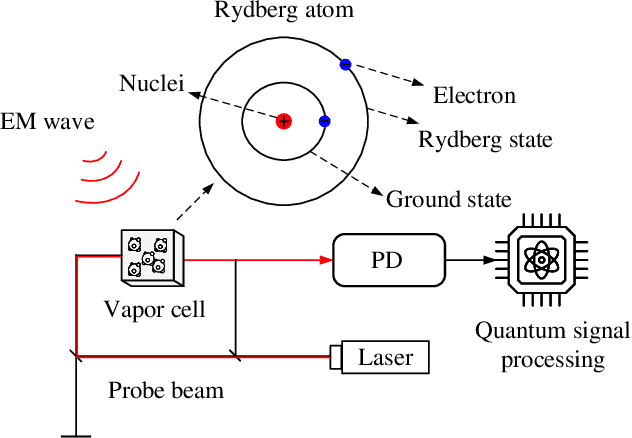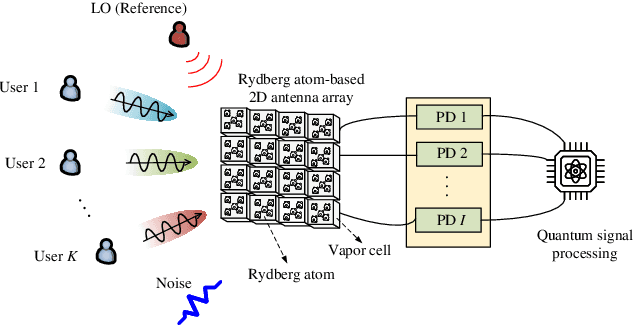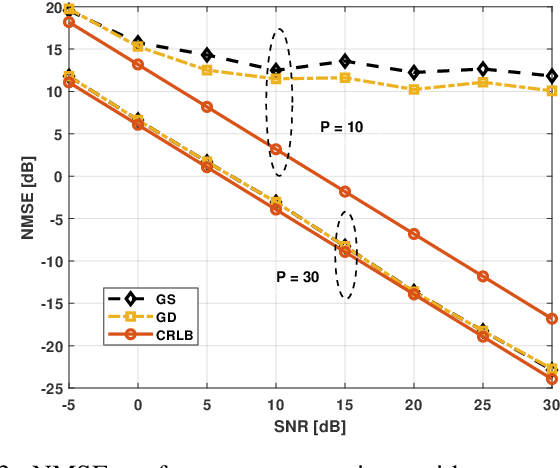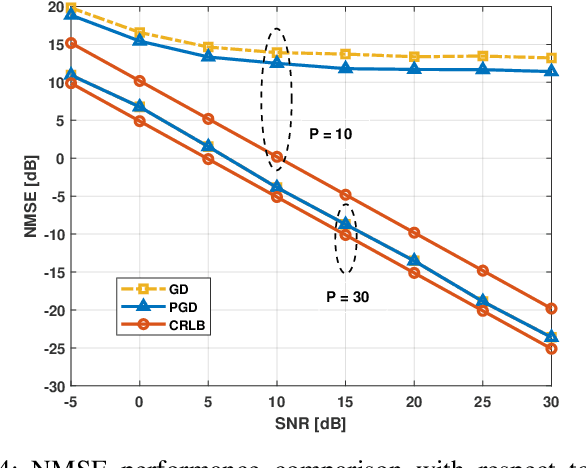Yik-Chung Wu
A Unified Distributed Algorithm for Hybrid Near-Far Field Activity Detection in Cell-Free Massive MIMO
Sep 18, 2025Abstract:A great amount of endeavor has recently been devoted to activity detection for massive machine-type communications in cell-free multiple-input multiple-output (MIMO) systems. However, as the number of antennas at the access points (APs) increases, the Rayleigh distance that separates the near-field and far-field regions also expands, rendering the conventional assumption of far-field propagation alone impractical. To address this challenge, this paper establishes a covariance-based formulation that can effectively capture the statistical property of hybrid near-far field channels. Based on this formulation, we theoretically reveal that increasing the proportion of near-field channels enhances the detection performance. Furthermore, we propose a distributed algorithm, where each AP performs local activity detection and only exchanges the detection results to the central processing unit, thus significantly reducing the computational complexity and the communication overhead. Not only with convergence guarantee, the proposed algorithm is unified in the sense that it can handle single-cell or cell-free systems with either near-field or far-field devices as special cases. Simulation results validate the theoretical analyses and demonstrate the superior performance of the proposed approach compared with existing methods.
Aligning Effective Tokens with Video Anomaly in Large Language Models
Aug 08, 2025Abstract:Understanding abnormal events in videos is a vital and challenging task that has garnered significant attention in a wide range of applications. Although current video understanding Multi-modal Large Language Models (MLLMs) are capable of analyzing general videos, they often struggle to handle anomalies due to the spatial and temporal sparsity of abnormal events, where the redundant information always leads to suboptimal outcomes. To address these challenges, exploiting the representation and generalization capabilities of Vison Language Models (VLMs) and Large Language Models (LLMs), we propose VA-GPT, a novel MLLM designed for summarizing and localizing abnormal events in various videos. Our approach efficiently aligns effective tokens between visual encoders and LLMs through two key proposed modules: Spatial Effective Token Selection (SETS) and Temporal Effective Token Generation (TETG). These modules enable our model to effectively capture and analyze both spatial and temporal information associated with abnormal events, resulting in more accurate responses and interactions. Furthermore, we construct an instruction-following dataset specifically for fine-tuning video-anomaly-aware MLLMs, and introduce a cross-domain evaluation benchmark based on XD-Violence dataset. Our proposed method outperforms existing state-of-the-art methods on various benchmarks.
Distributed Activity Detection for Cell-Free Hybrid Near-Far Field Communications
Jun 17, 2025Abstract:A great amount of endeavor has recently been devoted to activity detection for massive machine-type communications in cell-free massive MIMO. However, in practice, as the number of antennas at the access points (APs) increases, the Rayleigh distance that separates the near-field and far-field regions also expands, rendering the conventional assumption of far-field propagation alone impractical. To address this challenge, this paper considers a hybrid near-far field activity detection in cell-free massive MIMO, and establishes a covariance-based formulation, which facilitates the development of a distributed algorithm to alleviate the computational burden at the central processing unit (CPU). Specifically, each AP performs local activity detection for the devices and then transmits the detection result to the CPU for further processing. In particular, a novel coordinate descent algorithm based on the Sherman-Morrison-Woodbury update with Taylor expansion is proposed to handle the local detection problem at each AP. Moreover, we theoretically analyze how the hybrid near-far field channels affect the detection performance. Simulation results validate the theoretical analysis and demonstrate the superior performance of the proposed approach compared with existing approaches.
FieldFormer: Self-supervised Reconstruction of Physical Fields via Tensor Attention Prior
Jun 13, 2025Abstract:Reconstructing physical field tensors from \textit{in situ} observations, such as radio maps and ocean sound speed fields, is crucial for enabling environment-aware decision making in various applications, e.g., wireless communications and underwater acoustics. Field data reconstruction is often challenging, due to the limited and noisy nature of the observations, necessitating the incorporation of prior information to aid the reconstruction process. Deep neural network-based data-driven structural constraints (e.g., ``deeply learned priors'') have showed promising performance. However, this family of techniques faces challenges such as model mismatches between training and testing phases. This work introduces FieldFormer, a self-supervised neural prior learned solely from the limited {\it in situ} observations without the need of offline training. Specifically, the proposed framework starts with modeling the fields of interest using the tensor Tucker model of a high multilinear rank, which ensures a universal approximation property for all fields. In the sequel, an attention mechanism is incorporated to learn the sparsity pattern that underlies the core tensor in order to reduce the solution space. In this way, a ``complexity-adaptive'' neural representation, grounded in the Tucker decomposition, is obtained that can flexibly represent various types of fields. A theoretical analysis is provided to support the recoverability of the proposed design. Moreover, extensive experiments, using various physical field tensors, demonstrate the superiority of the proposed approach compared to state-of-the-art baselines.
Large-Scale Bayesian Tensor Reconstruction: An Approximate Message Passing Solution
May 22, 2025Abstract:Tensor CANDECOMP/PARAFAC decomposition (CPD) is a fundamental model for tensor reconstruction. Although the Bayesian framework allows for principled uncertainty quantification and automatic hyperparameter learning, existing methods do not scale well for large tensors because of high-dimensional matrix inversions. To this end, we introduce CP-GAMP, a scalable Bayesian CPD algorithm. This algorithm leverages generalized approximate message passing (GAMP) to avoid matrix inversions and incorporates an expectation-maximization routine to jointly infer the tensor rank and noise power. Through multiple experiments, for synthetic 100x100x100 rank 20 tensors with only 20% elements observed, the proposed algorithm reduces runtime by 82.7% compared to the state-of-the-art variational Bayesian CPD method, while maintaining comparable reconstruction accuracy.
Nonparametric Teaching for Graph Property Learners
May 21, 2025Abstract:Inferring properties of graph-structured data, e.g., the solubility of molecules, essentially involves learning the implicit mapping from graphs to their properties. This learning process is often costly for graph property learners like Graph Convolutional Networks (GCNs). To address this, we propose a paradigm called Graph Neural Teaching (GraNT) that reinterprets the learning process through a novel nonparametric teaching perspective. Specifically, the latter offers a theoretical framework for teaching implicitly defined (i.e., nonparametric) mappings via example selection. Such an implicit mapping is realized by a dense set of graph-property pairs, with the GraNT teacher selecting a subset of them to promote faster convergence in GCN training. By analytically examining the impact of graph structure on parameter-based gradient descent during training, and recasting the evolution of GCNs--shaped by parameter updates--through functional gradient descent in nonparametric teaching, we show for the first time that teaching graph property learners (i.e., GCNs) is consistent with teaching structure-aware nonparametric learners. These new findings readily commit GraNT to enhancing learning efficiency of the graph property learner, showing significant reductions in training time for graph-level regression (-36.62%), graph-level classification (-38.19%), node-level regression (-30.97%) and node-level classification (-47.30%), all while maintaining its generalization performance.
Deep Unfolding with Kernel-based Quantization in MIMO Detection
May 19, 2025Abstract:The development of edge computing places critical demands on energy-efficient model deployment for multiple-input multiple-output (MIMO) detection tasks. Deploying deep unfolding models such as PGD-Nets and ADMM-Nets into resource-constrained edge devices using quantization methods is challenging. Existing quantization methods based on quantization aware training (QAT) suffer from performance degradation due to their reliance on parametric distribution assumption of activations and static quantization step sizes. To address these challenges, this paper proposes a novel kernel-based adaptive quantization (KAQ) framework for deep unfolding networks. By utilizing a joint kernel density estimation (KDE) and maximum mean discrepancy (MMD) approach to align activation distributions between full-precision and quantized models, the need for prior distribution assumptions is eliminated. Additionally, a dynamic step size updating method is introduced to adjust the quantization step size based on the channel conditions of wireless networks. Extensive simulations demonstrate that the accuracy of proposed KAQ framework outperforms traditional methods and successfully reduces the model's inference latency.
iMacSR: Intermediate Multi-Access Supervision and Regularization in Training Autonomous Driving Models
May 01, 2025Abstract:Deep Learning (DL)-based street scene semantic understanding has become a cornerstone of autonomous driving (AD). DL model performance heavily relies on network depth. Specifically, deeper DL architectures yield better segmentation performance. However, as models grow deeper, traditional one-point supervision at the final layer struggles to optimize intermediate feature representations, leading to subpar training outcomes. To address this, we propose an intermediate Multi-access Supervision and Regularization (iMacSR) strategy. The proposed iMacSR introduces two novel components: (I) mutual information between latent features and ground truth as intermediate supervision loss ensures robust feature alignment at multiple network depths; and (II) negative entropy regularization on hidden features discourages overconfident predictions and mitigates overfitting. These intermediate terms are combined into the original final-layer training loss to form a unified optimization objective, enabling comprehensive optimization across the network hierarchy. The proposed iMacSR provides a robust framework for training deep AD architectures, advancing the performance of perception systems in real-world driving scenarios. In addition, we conduct theoretical convergence analysis for the proposed iMacSR. Extensive experiments on AD benchmarks (i.e., Cityscapes, CamVid, and SynthiaSF datasets) demonstrate that iMacSR outperforms conventional final-layer single-point supervision method up to 9.19% in mean Intersection over Union (mIoU).
FedEMA: Federated Exponential Moving Averaging with Negative Entropy Regularizer in Autonomous Driving
May 01, 2025Abstract:Street Scene Semantic Understanding (denoted as S3U) is a crucial but complex task for autonomous driving (AD) vehicles. Their inference models typically face poor generalization due to domain-shift. Federated Learning (FL) has emerged as a promising paradigm for enhancing the generalization of AD models through privacy-preserving distributed learning. However, these FL AD models face significant temporal catastrophic forgetting when deployed in dynamically evolving environments, where continuous adaptation causes abrupt erosion of historical knowledge. This paper proposes Federated Exponential Moving Average (FedEMA), a novel framework that addresses this challenge through two integral innovations: (I) Server-side model's historical fitting capability preservation via fusing current FL round's aggregation model and a proposed previous FL round's exponential moving average (EMA) model; (II) Vehicle-side negative entropy regularization to prevent FL models' possible overfitting to EMA-introduced temporal patterns. Above two strategies empower FedEMA a dual-objective optimization that balances model generalization and adaptability. In addition, we conduct theoretical convergence analysis for the proposed FedEMA. Extensive experiments both on Cityscapes dataset and Camvid dataset demonstrate FedEMA's superiority over existing approaches, showing 7.12% higher mean Intersection-over-Union (mIoU).
Channel Estimation for Rydberg Atomic Receivers
Mar 12, 2025



Abstract:The rapid development of the quantum technology presents huge opportunities for 6G communications. Leveraging the quantum properties of highly excited Rydberg atoms, Rydberg atom-based antennas present distinct advantages, such as high sensitivity, broad frequency range, and compact size, over traditional antennas. To realize efficient precoding, accurate channel state information is essential. However, due to the distinct characteristics of atomic receivers, traditional channel estimation algorithms developed for conventional receivers are no longer applicable. To this end, we propose a novel channel estimation algorithm based on projection gradient descent (PGD), which is applicable to both one-dimensional (1D) and twodimensional (2D) arrays. Simulation results are provided to show the effectiveness of our proposed channel estimation method.
 Add to Chrome
Add to Chrome Add to Firefox
Add to Firefox Add to Edge
Add to Edge